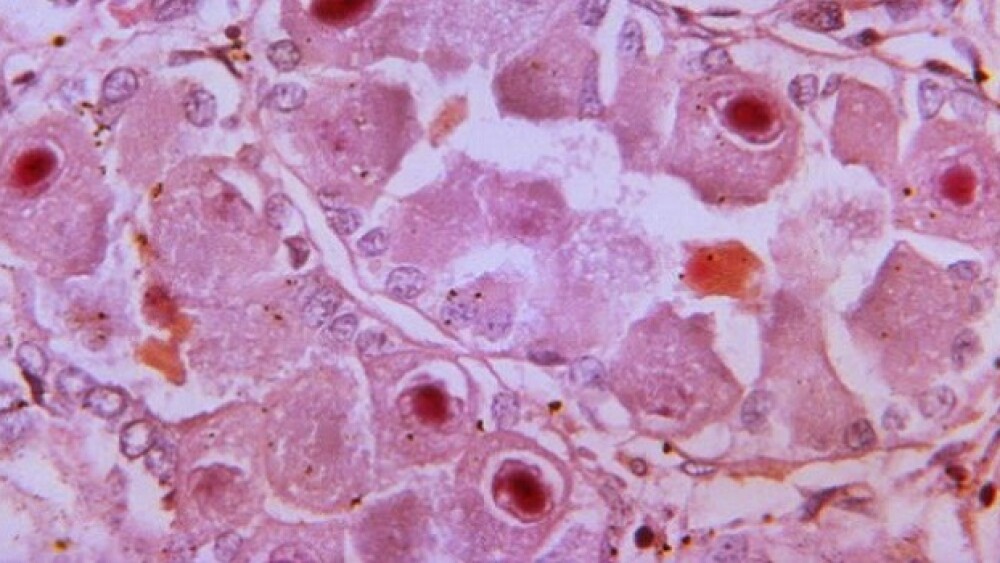Despite the Phase III failure, Travere and partner CSL Vifor will explore potential regulatory paths for sparsentan as a treatment for focal segmental glomerulosclerosis.
Pictured: Photomicrograph of a Lendrum-stained kidney tissue specimen/CDC/Rosalie B. Haraszti, M.D.
Topline data from the Phase III DUPLEX study showed Travere Therapeutics’ sparsentan does not significantly improve kidney function in the rare kidney disease focal segmental glomerulosclerosis (FSGS), the company announced Monday.
In an investor call Monday afternoon, Travere CEO Eric Dube said while the company finds this failure disappointing, it is encouraged by the favorable trends in secondary efficacy metrics and good overall tolerability profile of sparsentan in FSGS patients. FSGS is a rare kidney disease characterized by progressive scarring of the kidney resulting in proteinuria (high level of protein in urine) and rapid decline in kidney function.
“We believe there is strong rationale to engage with regulators to understand if there is a path to enable sparsentan to have a role in treating FSGS,” Dube said. The company will take the overall sparsentan Phase III data to the FDA to explore a potential path to registration. In Europe, Travere will work with its collaborator Swiss pharma CSL Vifor in engaging with the European Medicines Agency.
With 371 patients enrolled, DUPLEX is the largest interventional trial in FSGS to date, according to Travere. Participants were randomized to receive either sparsentan or Sanofi’s Avapro (irbesartan) as an active control. The primary endpoint of the study was change in kidney function, as measured by the total slope of the estimated glomerular filtration rate (eGFR) over 108 weeks of treatment.
Treatment with sparsentan led to a 0.3 mL/min/1.73m2 improvement in eGFR total slope per year as compared with Avapro. Though the efficacy data favored sparsentan, the treatment effect fell short of statistical significance, according to the announcement.
Sparsentan also showed signals of efficacy as assessed by exploratory endpoints, including urinary protein-to-creatinine ratio by 50%, partial remission of proteinuria and complete remission.
As for safety, preliminary assessments indicate that sparsentan is well-tolerated with an overall adverse event profile consistent with what had been observed in previous studies of the drug.
These data follow a February 2021 data drop showing that after 36 weeks of treatment, sparsentan met its interim endpoint of inducing significantly better FSGS partial remission of proteinuria than Avapro.
Affecting some 40,000 children and adults in the U.S., FSGS is a rare kidney disease characterized by scarring in the kidney, which impairs its otherwise healthy filtering function and typically culminates in kidney failure. Proteinuria, the presence of protein in the urine, is also a hallmark of FSGS and further aggravates the disease due to its toxic effects on the kidney’s tubules.
There are currently no approved pharmacologic interventions for treating FSGS.
Sparsentan is a small molecule antagonist of both the endothelin type A and angiotensin II type 1 receptors. According to Travere, preclinical data show that blocking both pathways could help reduce proteinuria and prevent kidney scarring, both key pathological processes in FSGS.
This dual-blocking mechanism of action also underpins sparsentan’s therapeutic benefit in other rare chronic kidney diseases. In February 2023, the FDA approved sparsentan, now marketed as Filspari, for primary IgA nephropathy under its accelerated pathway.
Filspari is indicated for patients who are at risk of rapid disease progression. Along with the accelerated approval, Travere is required to run a Risk Evaluation Mitigation Strategies (REMS) program, which includes training prescribers and monitoring patients. Filspari is the first non-immunosuppressive treatment for this indication.
Tristan Manalac is an independent science writer based in metro Manila, Philippines. He can be reached at tristan@tristanmanalac.com or tristan.manalac@biospace.com.






